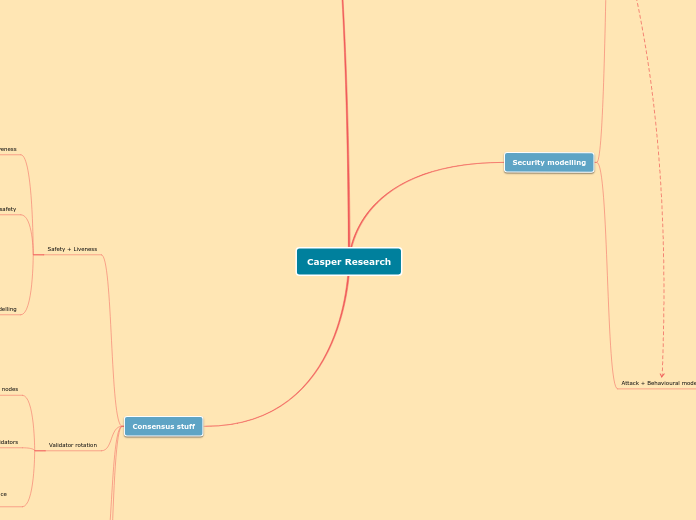Casper Research
Security modelling
Projection of deposit amounts
From projections of total Validator revenues
in-protocol revenues (fees + issuance)
Target amount bonded
Auction mechanism for bonding rate
if it gets gamed, then there might be too much issuance
Reducing return in amount bonded
introduces censorship risk
Target issuance + fees
fixed inflation
may be over paying, no price discovery
auction mechanism
Fees only
definite price discovery
free p2p validator2user market
mandatory in-protocol minimum gasprice
redistributed
burned
gives anti-Sybil measure on users
useful for signaling? governance?
maybe insufficient deposits in this model?
market capitalization
user cost vs cost to coin holders
extra-protocol fees (subscriptions?)
Bribes
From projections of Validator costs
Operating costs
Cost of capital
how (if at all) do we want to eventually measure this?
Infer from amount bonded in auction
Give a risk-free opportunity to stake
Speculators who are longer ether have lower CoC
cost of electrical, capital and maintenance
cost of security devices and/or consulting
cost of bandwidth
In-protocol penalties
Attack + Behavioural models
Attacker modelling
Attacker profiles
State attacker
argument about whether it's worth taking seriously
Criminal organizations
Miners/Validators
Crisis speculators
Random attacker
power law distribution budget
Poisson process attack times
Attacker motivations
Extra-protocol profit from attack
shorting cryptocurrency
Bribes
Anti-competitive behaviour
Power through censorship
Self/collective defense
Attack modelling
External attacks
Buying enough bonds to attack
Buying some bonds + griefing until majority achieved
Technical fault attacks
Byzantine faults
Crash faults
Network asynchrony
Incentivized attacks
Game theory
In independent choice
Agent based/evolutionary modelling
Nash Equilibrium
With bribing
How much does it cost to cause failure?
Liveness failures
Safety failures
Selfish (mining) behaviour
Coordinated choice
Fairness
Shapely values
Greifing
Stability
Strong Nash equilibrium
Core
Coalition-proof Nash equilibrium
Market models
Perfectly competitive markets
No coordination between validators
Nash equilibrium
Evolutionary models
No significant market concentration
Efficient market equilibrium
Oligopolistic markets
Not perfect competition
Coordination between Validators is possible
The Cartel model
What is the in-protocol cost/benefit to cartel of attacking?
Liveness failures
Censorship
Cost of penalties due to censorship
Increased returns from censorship
Preventing consensus
Revenue from preventing validator rotation
cost of penalties due to liveness failures
Unavailability attack
Safety failure
Reversion
cost of lost deposits (when equivocation is required)
Revenue from double spending
Invalid blocks
cost of lost deposits
revenue from misleading light clients (?)
Price/Quantity leadership
Behavioural models
Do we need to conduct our own experiments?
Rewards vs Penalties
Security Deposit, issuance, and fee management
Mechanism design questions
Utility of protocol states
Inference of strategies from protocol states
Payoff structure
Predictions from behavioural/equilibrium models
Validator payoffs
in-protocol revenues
Fees
Issuance
in-protocol expenses
penalties for liveness failures
Penalizing online nodes for censoring missing nodes
opens opportunity for griefing as anti-competitive behavior
maximally attributable liveness faults
i.e. expect blockchain and penalize those who may have caused orphaned (and included) forks
Strategy inference functions
penalties for safety violations
perfectly attributable Byzantine faults
requires censorship resistance
otherwise, there won't be consensus between validators on the evidence
note that subjective assignment of Byzantine node's weight to zero always works
Placing and withdrawing deposits
Long deposit withdrawal times allows for penalties on Byzantine faults
On order of censorship resistance timeline of the blockchain + timeline of client gossip for discovery of equivocation
On the order of time that clients are expected to come online (weak subjectivity timeline)
Logging on and off without compromising safety
Limited slots, auctions, and queues
Consensus stuff
Safety + Liveness
Minimum synchronicity for liveness
Consensus liveness
Estimate safety liveness
Asynchronous safety
Consensus safety
Estimate safety
Estimate safety decision rules have estimate safety
ideal adversary (and lower bounds)
Fault modelling
Fault models/Fault contexts
Byzantine faults
Crash faults
Network asynchrony
Fault attribution
Perfectly attributable safety violations
minimum slashing conditions
Maximally attributable liveness faults
Validator rotation
Removing Byzantine nodes
countersigning to get consensus on next group of validators
see Vitalik's and Yoichi's blogs
how is this done without a consensus safety fault tolerance threshold, again?
VM replication
ranked voting as canonical estimators
having the longest chain as a canonical estimator
composing binary decisions
timestamp estimates giving order
finality gadget on top of existing blockchain
Overhead
Latency vs Overhead
For finality times
For pre-consensus confirmations
in-protocol guarantees vs assumptions
e.g. block availability guarantee for light clients
Redundancy-free-ness versus computational ease of honest Validator strategy
